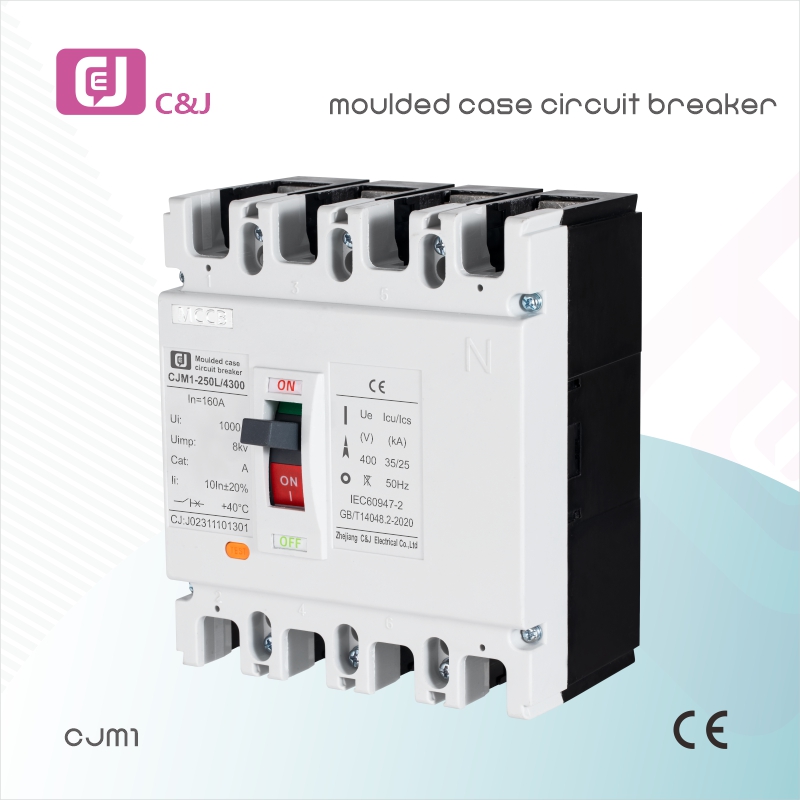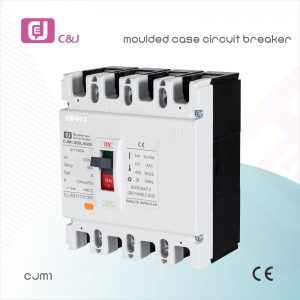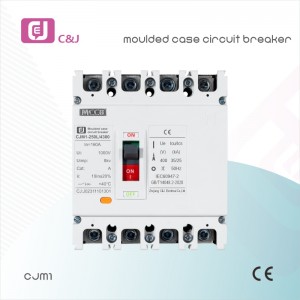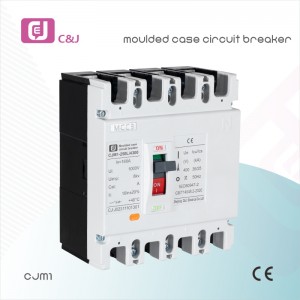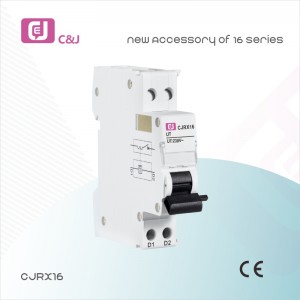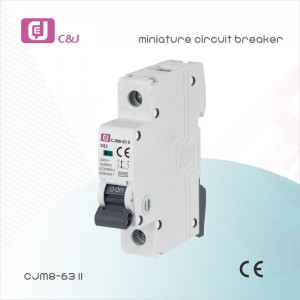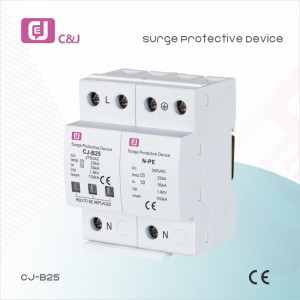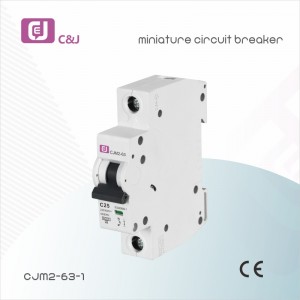China Manufacturer CJMM1-250L/4300 160A 35/25kA Electrical MCCB Moulded case circuit breaker
Product Model
CJ:Enterprise code
M:Moulded case circuit breaker
1:Design No
□:Rated current of frame
□:Breaking capacity characteristic code/S denotes standard type (S can be omitted)H denotes higher type
Note: There are four types of neutral pole (N pole) for four phases product.The neutral pole of type A is not equipped with over-current tripping element, its always switched on, and it is not switched on or off together with other three poles.
The neutral pole of type B is not equipped with over-current tripping element, and it’s switched on or off together with other three poles(the neutral pole is switched on before being switched off)The neutral pole of type C is equipped with over-current tripping element, and it’s switched on or off together with other three poles(the neutral pole is switched on before being switched off) The neutral pole of type D is equipped with over-current tripping element, it’s always switched on and is not switched on or off together with other three poles.
Table 1
| Accessory name | Electronic release | Compound release | ||||||
| Auxiliary contact,under voltage release,alam contact | 287 | 378 | ||||||
| Two auxiliary contact sets,alarm contact | 268 | 368 | ||||||
| Shunt release, alarm contact, auxiliary contact | 238 | 348 | ||||||
| Under voltage release,alarm contact | 248 | 338 | ||||||
| Auxiliary contact alarm contact | 228 | 328 | ||||||
| Shunt release alarm contact | 218 | 318 | ||||||
| Auxiliary contact under-voltage release | 270 | 370 | ||||||
| Two auxiliary contact sets | 260 | 360 | ||||||
| Shunt release under-voltage release | 250 | 350 | ||||||
| Shunt release auxiliary contact | 240 | 340 | ||||||
| Under-voltage release | 230 | 330 | ||||||
| Auxiliary contact | 220 | 320 | ||||||
| Shunt release | 210 | 310 | ||||||
| Alarm contact | 208 | 308 | ||||||
| No accessory | 200 | 300 | ||||||
Classification
- By breaking capacity: a standard type(type S) b higher breaking capacity type(type H)
- By connection mode: a front board connection, b back board connection, c plugin type
- By operation mode: a direct handle operation, b rotation handle operation,c electrical operation
- By number of poles: 1P, 2P, 3P, 4P
- By accessory: alarm contact, auxiliary contact, shunt release, under voltage release
Normal Service Condition
- The altitude of the installation site shall not exceed 2000m
- Ambient air temperature
- The ambient air temperature shall not exceed +40℃
- The average value shall not exceed +35℃ with in 24 hours
- The ambient air temperature shall not be less than -5℃
- Atmosphere condition:
- 1There lative humidity of atmosp here shall not exceed 50% at highest temperature of +40℃,and it can be higher atalower temperature,when theaver agelowest temperature in the wettest month doesn’t exceed 25℃ can be 90%,conden sationon product surfacedue to temperature change must be takenin to account.
- The pollution level is class 3
Main Technical Parameter
| 1 Rated value of circuit breakers | ||||||||
| Model | Imax (A) | Specifications (A) | Rated Operation Voltage(V) | Rated Insulation Voltage(V) | Icu (kA) | Ics (kA) | Number of Poles (P) | Arcing Distance (mm) |
| CJMM1-63S | 63 | 6,10,16,20 25,32,40, 50,63 |
400 | 500 | 10* | 5* | 3 | ≤50 |
| CJMM1-63H | 63 | 400 | 500 | 15* | 10* | 3,4 | ||
| CJMM1-100S | 100 | 16,20,25,32 40,50,63, 80,100 |
690 | 800 | 35/10 | 22/5 | 3 | ≤50 |
| CJMM1-100H | 100 | 400 | 800 | 50 | 35 | 2,3,4 | ||
| CJMM1-225S | 225 | 100,125, 160,180, 200,225 |
690 | 800 | 35/10 | 25/5 | 3 | ≤50 |
| CJMM1-225H | 225 | 400 | 800 | 50 | 35 | 2,3,4 | ||
| CJMM1-400S | 400 | 225,250, 315,350, 400 |
690 | 800 | 50/15 | 35/8 | 3,4 | ≤100 |
| CJMM1-400H | 400 | 400 | 800 | 65 | 35 | 3 | ||
| CJMM1-630S | 630 | 400,500, 630 |
690 | 800 | 50/15 | 35/8 | 3,4 | ≤100 |
| CJMM1-630H | 630 | 400 | 800 | 65 | 45 | 3 | ||
| Note: When the test parameters for the 400V, 6A without heating release | ||||||||
| 2 Inverse time breaking operation characteristic when each pole of overcurrent release for power distribution is powered on at the same time | ||||||||
| Item of test Current (I/In) | Test time area | Initial state | ||||||
| Non-tripping current 1.05In | 2h(n>63A),1h(n<63A) | Cold state | ||||||
| Tripping current 1.3In | 2h(n>63A),1h(n<63A) | Proceed immediately after No.1 test |
||||||
| 3 Inverse time breaking operation characteristic when each pole of over- current release for motor protection is powered on at the same time. |
||||||||
| Setting Current Conventional time Initial State | Note | |||||||
| 1.0In | >2h | Cold State | ||||||
| 1.2In | ≤2h | Proceeded immediately after the No.1 test | ||||||
| 1.5In | ≤4min | Cold State | 10≤In≤225 | |||||
| ≤8min | Cold State | 225≤In≤630 | ||||||
| 7.2In | 4s≤T≤10s | Cold State | 10≤In≤225 | |||||
| 6s≤T≤20s | Cold State | 225≤In≤630 | ||||||
| 4 The instantaneous operation characteristic of circuit breaker for power distribution shall be set as 10in+20%, and the one of circuit breaker for motor protection shall be set as12ln±20% |
Outline Installation Size
CJMM1-63, 100, 225, Outline and Installation Sizes (Front board connection)
| Sizes(mm) | Model Code | |||||||
| CJMM1-63S | CJMM1-63H | CJMM1-63S | CJMM1-100S | CJMM1-100H | CJMM1-225S | CJMM1-225 | ||
| Outline Sizes | C | 85.0 | 85.0 | 88.0 | 88.0 | 102.0 | 102.0 | |
| E | 50.0 | 50.0 | 51.0 | 51.0 | 60.0 | 52.0 | ||
| F | 23.0 | 23.0 | 23.0 | 22.5 | 25.0 | 23.5 | ||
| G | 14.0 | 14.0 | 17.5 | 17.5 | 17.0 | 17.0 | ||
| G1 | 6.5 | 6.5 | 6.5 | 6.5 | 11.5 | 11.5 | ||
| H | 73.0 | 81.0 | 68.0 | 86.0 | 88.0 | 103.0 | ||
| H1 | 90.0 | 98.5 | 86.0 | 104.0 | 110.0 | 127.0 | ||
| H2 | 18.5 | 27.0 | 24.0 | 24.0 | 24.0 | 24.0 | ||
| H3 | 4.0 | 4.5 | 4.0 | 4.0 | 4.0 | 4.0 | ||
| H4 | 7.0 | 7.0 | 7.0 | 7.0 | 5.0 | 5.0 | ||
| L | 135.0 | 135.0 | 150.0 | 150.0 | 165.0 | 165.0 | ||
| L1 | 170.0 | 173.0 | 225.0 | 225.0 | 360.0 | 360.0 | ||
| L2 | 117.0 | 117.0 | 136.0 | 136.0 | 144.0 | 144.0 | ||
| W | 78.0 | 78.0 | 91.0 | 91.0 | 106.0 | 106.0 | ||
| W1 | 25.0 | 25.0 | 30.0 | 30.0 | 35.0 | 35.0 | ||
| W2 | - | 100.0 | - | 120.0 | - | 142.0 | ||
| W3 | - | - | 65.0 | 65.0 | 75.0 | 75.0 | ||
| Install Sizes | A | 25.0 | 25.0 | 30.0 | 30.0 | 35.0 | 35.0 | |
| B | 117.0 | 117.0 | 128.0 | 128.0 | 125.0 | 125.0 | ||
| od | 3.5 | 3.5 | 4.5 | 4.5 | 5.5 | 5.5 | ||
CJMM1-400,630,800,Outline and Installation Sizes (Front board connection)
| Sizes(mm) | Model Code | |||||||
| CJMM1-400S | CJMM1-630S | |||||||
| Outline Sizes | C | 127 | 134 | |||||
| C1 | 173 | 184 | ||||||
| E | 89 | 89 | ||||||
| F | 65 | 65 | ||||||
| G | 26 | 29 | ||||||
| G1 | 13.5 | 14 | ||||||
| H | 107 | 111 | ||||||
| H1 | 150 | 162 | ||||||
| H2 | 39 | 44 | ||||||
| H3 | 6 | 6.5 | ||||||
| H4 | 5 | 7.5 | ||||||
| H5 | 4.5 | 4.5 | ||||||
| L | 257 | 271 | ||||||
| L1 | 465 | 475 | ||||||
| L2 | 225 | 234 | ||||||
| W | 150 | 183 | ||||||
| W1 | 48 | 58 | ||||||
| W2 | 198 | 240 | ||||||
| A | 44 | 58 | ||||||
| Install Sizes | A1 | 48 | 58 | |||||
| B | 194 | 200 | ||||||
| Od | 8 | 7 | ||||||
Back Board Connection Cut-out Diagram Plug In
| Sizes(mm) | Model Code | ||||||
| CJMM1-63S CJMM1-63H |
CJMM1-100S CJMM1-100H |
CJMM1-225S CJMM1-225H |
CJMM1-400S | CJMM1-400H | CJMM1-630S CJMM1-630H |
||
| Sizes Of Back Board Connection Plug in Type | A | 25 | 30 | 35 | 44 | 44 | 58 |
| od | 3.5 | 4.5*6 deep hole |
3.3 | 7 | 7 | 7 | |
| od1 | - | - | - | 12.5 | 12.5 | 16.5 | |
| od2 | 6 | 8 | 8 | 8.5 | 9 | 8.5 | |
| oD | 8 | 24 | 26 | 31 | 33 | 37 | |
| oD1 | 8 | 16 | 20 | 33 | 37 | 37 | |
| H6 | 44 | 68 | 66 | 60 | 65 | 65 | |
| H7 | 66 | 108 | 110 | 120 | 120 | 125 | |
| H8 | 28 | 51 | 51 | 61 | 60 | 60 | |
| H9 | 38 | 65.5 | 72 | - | 83.5 | 93 | |
| H10 | 44 | 78 | 91 | 99 | 106.5 | 112 | |
| H11 | 8.5 | 17.5 | 17.5 | 22 | 21 | 21 | |
| L2 | 117 | 136 | 144 | 225 | 225 | 234 | |
| L3 | 117 | 108 | 124 | 194 | 194 | 200 | |
| L4 | 97 | 95 | 9 | 165 | 163 | 165 | |
| L5 | 138 | 180 | 190 | 285 | 285 | 302 | |
| L6 | 80 | 95 | 110 | 145 | 155 | 185 | |
| M | M6 | M8 | M10 | - | - | - | |
| K | 50.2 | 60 | 70 | 60 | 60 | 100 | |
| J | 60.7 | 62 | 54 | 129 | 129 | 123 | |
| M1 | M5 | M8 | M8 | M10 | M10 | M12 | |
| W1 | 25 | 35 | 35 | 44 | 44 | 58 | |
What is MCCB?
Molded case circuit breakers are electrical protection devices that are designed to protect the electrical circuit from excessive current. This excessive current can be caused due to an overload or short circuit. The molded case circuit breakers can be used in a wide range of voltages and frequencies with a defined lower and upper limit of adjustable trip settings. In addition to tripping mechanisms, MCCBs can also be used as manual disconnection switches in case of emergency or maintenance operations. MCCBs are standardized and tested for overcurrent, voltage surge, and fault protection to ensure safe operation in all environments and applications. They work effectively as a reset switch for an electric circuit to disconnect power and minimize damage caused by a circuit overload, ground fault, short circuits, or when current exceeds the current limiting.
Applications
The application of MCCB has completely changed the way of circuit protection. MCCB refers to plastic case circuit breaker, which is widely used in various industries for its excellent performance and reliability. This article will explore the different applications of MCCBs and how they can have a significant impact on electrical safety.
MCCBs are widely used in industrial environments where circuit protection is critical. These circuit breakers are designed to handle high currents and provide reliable protection against overloads, short circuits, and other electrical faults. One of the main advantages of MCCBs is their ability to automatically interrupt the flow of electricity in the event of a fault, thus preventing any potential dangers such as fire or damage to expensive equipment.
In commercial buildings, MCCBs are used to protect circuits that power lighting systems, HVAC systems, and other critical equipment. These circuit breakers ensure that in the event of a fault, the affected portion of the circuit is disconnected without interrupting power to the rest of the building. This ability to selectively isolate faulty circuits saves time and prevents unnecessary downtime throughout the facility.
Another important application of MCCB is in the field of renewable energy. As the demand for green energy continues to increase, molded case circuit breakers play an important role in protecting the electrical systems of solar power plants and wind turbines. These circuit breakers ensure that the electricity generated is safely transferred to the grid without causing any damage to equipment or personnel.
Due to their sturdy construction and reliable performance, molded case circuit breakers are also widely used in the oil and gas industry. MCCB is responsible for circuit protection in a variety of applications including offshore platforms, refineries and pipeline installations. These circuit breakers are designed to withstand extreme environmental conditions, ensuring the continued safe operation of critical electrical systems.
MCCB has also entered the residential field to provide efficient and reliable solutions for home circuit protection. As the number of appliances and systems within a home increases, so does the risk of electrical failure. MCCB protects residential circuits from overloads and short circuits, giving homeowners peace of mind and increasing electrical safety.
Additionally, MCCBs are widely used in data centers to protect critical equipment and systems that support information technology infrastructure. These circuit breakers are critical to preventing data loss due to electrical faults, ensuring uninterrupted operations, and protecting valuable information stored in servers and other network equipment.
In summary, molded case circuit breakers are used in various industries and sectors, making them an important part of circuit protection. Their ability to handle high currents, interrupt current flow during faults, and rugged construction make them a popular choice for ensuring electrical safety. Whether in industrial settings, commercial buildings, renewable energy installations, oil and gas facilities, residences or data centers, MCCB has proven to be a reliable and efficient solution. As technology continues to advance, the application and importance of molded case circuit breakers will only grow, further enhancing electrical protection and safety in various fields.


